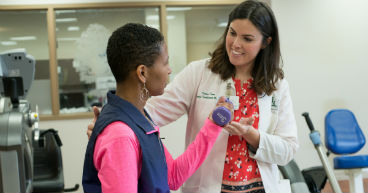
Most people who survive breast cancer don’t get cancer again. Still, it’s possible for the cancer to return—called a recurrence—at some point in the future. That’s why keeping up with cancer screenings and overall health is so important once you enter survivorship. It’s also vital because some people with a history of breast cancer can develop a completely unrelated cancer—called a secondary cancer—later on.
Past research on secondary cancer risk among people who survive breast cancer found that women were 27 percent more likely—and men 28 percent more likely—to develop another cancer compared with people with no history of breast cancer. But a new study published in The Lancet in April suggests the risk may be greater depending on the type of cancer.
For example, according to the study, women who survive breast cancer have an 87 percent greater risk for developing endometrial cancer than other women. And men who survive the disease are 62 percent more likely to develop pancreatic cancer than other men.
“It’s not always known why some cancer survivors develop a secondary unrelated cancer,” Luke Chen, MD, a Medical Oncologist and Hematologist at City of Hope© Orange County Lennar Foundation Cancer Center tells Medical News Today. “We do know that radiation therapy for one form of cancer can put some people at a higher risk for developing a second cancer, such as several types of leukemia. Certain kinds of chemotherapy have also been linked with second cancers such as myelodysplastic syndrome, acute myelogenous leukemia (or myeloid leukemia) and acute lymphocytic leukemia.”
Two other factors affecting a survivor’s risk that the study’s researchers point to are age and socioeconomic status.
In this article, we’ll explore:
- Breast cancer survivors and secondary cancer risk
- Which secondary cancers are most likely to develop
- Ways breast cancer survivors may reduce their cancer risk
If you’ve been diagnosed with breast cancer and are interested in a second opinion on your diagnosis and treatment plan or are concerned about your future cancer risk, call us or chat online with a member of our team.
Breast cancer survivors and secondary cancer risk
The study analyzed data from almost 600,000 breast cancer survivors in England between 1995 and 2019, looking at whether—and how often—they developed a secondary cancer. Researchers found the risk of a secondary cancer was higher in women who’d been diagnosed with breast cancer before age 50, with 86 percent more likely to develop a secondary cancer. Women who were diagnosed with breast cancer after age 50 had a 17 percent increased risk.
In addition to age, economic status plays a role in a breast cancer survivor’s risk, the study’s researchers reported. They found that women from more socioeconomically disadvantaged backgrounds were at a 35 percent higher risk for developing a secondary cancer compared with others.
“The study’s finding linking socioeconomic factors to a higher risk of cancer recurrence is concerning but not surprising,” Dr. Chen says. “Lack of access to breast cancer resources is an all-too-common occurrence in underserved communities, including those in the United States.”
Which secondary cancers are most likely to develop
The most common secondary cancer breast cancer survivors develop is another breast cancer. A new cancer may develop in the opposite breast or in the same breast. According to the study, for example, women with a history of breast cancer are twice as likely to develop cancer in their other breast as the general population. And men who’ve had breast cancer are 55 times more likely to develop cancer in their other breast.
Below are some of the secondary cancers the study’s researchers found breast cancer survivors are at an increased risk for—compared with people who don’t have a history of the disease—including how likely they are to develop.
In women:
- Endometrial (87 percent)
- Myeloid leukemia (58 percent)
- Ovarian (25 percent)
- Pancreatic (18 percent)
In men:
Ways breast cancer survivors may reduce their cancer risk
Researchers believe this elevated risk should be considered when planning breast cancer survivors’ screening and prevention schedules going forward. Men and women who survived breast cancer also should be vigilant about their lifestyle behaviors, which are risk factors they may control.
“The lifestyle factors known to contribute to decreasing a person’s risk of developing a first cancer also apply to decreasing the risk of a secondary cancer,” Dr. Chen says. “This includes maintaining a healthy weight, not smoking, not drinking too much alcohol, eating a healthy diet and exercising regularly.”
If you’ve been diagnosed with breast cancer and are interested in a second opinion on your diagnosis and treatment plan or are concerned about your future cancer risk, call us or chat online with a member of our team.



